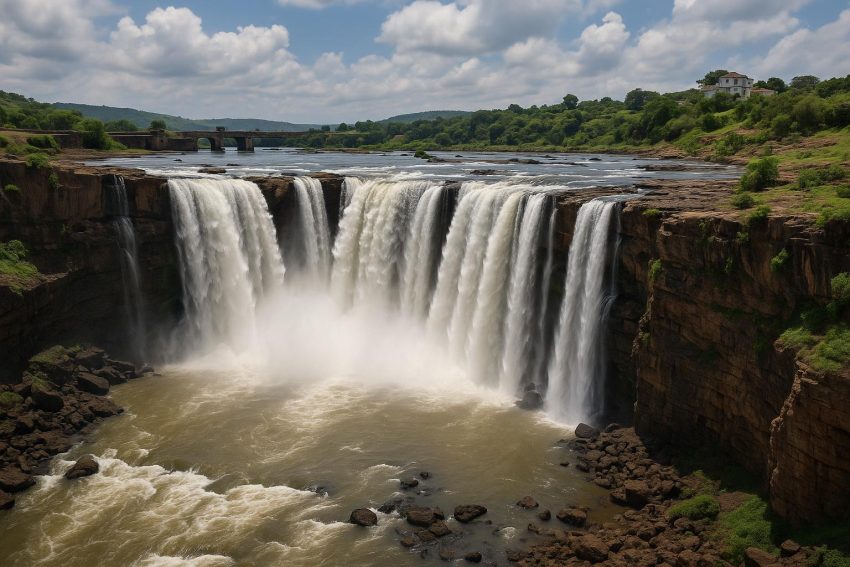Introduction to Gokak Falls
Gokak Falls, a natural beauty located on the Ghataprabha River in the Belgaum district of Karnataka, India, is renowned for its striking resemblance to Niagara Falls, albeit on a smaller scale. The region surrounding Gokak Falls is rich in history and natural diversity, making it a popular destination for tourists and nature enthusiasts.
Geographical Features
The Gokak Falls cascade down from a height of about 52 meters (170 feet), making it one of the prominent waterfalls in the region. The waterfall spans a width of 177 meters (580 feet) and is characterized by its reddish-brown rocky bed, a result of the Deccan Plateau’s volcanic activity.
The geology of the area plays a significant role in the aesthetics of the falls. The Deccan Plateau, known for its extensive volcanic basalts, gives the cascade a unique texture and color. These geological formations are not just impressive to look at but also offer valuable insights into the volcanic history of the region. The surrounding topography is a mix of plains and low hills, contributing to a diverse ecological zone that supports various species of flora and fauna, emphasizing the area’s biodiversity.
Hydrology
The Ghataprabha River, which originates from the Western Ghats, traverses across the Deccan Plateau, ultimately forming the Gokak Falls before continuing its journey eastward. This river is vital for the local agrarian communities, serving as a primary water source for irrigation and other agricultural activities.
The river is spanned by a historic stone bridge, offering visitors an excellent vantage point to observe the waterfall. This bridge not only serves as a functional structure connecting local communities but also stands as an architectural marvel of its time. Built over a century ago, it withstands the test of time, symbolizing the age-old connection between nature and human intervention in the region.
Historical Significance
A significant feature of Gokak Falls is the quaint, old hydroelectric power station located near the falls, marking the beginning of Karnataka’s journey into hydroelectricity in the early 20th century. The establishment of this power station transformed the region, bringing in not just electricity but also a wave of modernization and economic development in surrounding areas. It stands as a testament to the foresight of early 20th-century engineers who capitalized on the waterfall’s energy.
This station is one of the oldest in India, emphasizing the region’s historical contribution to the country’s industrial development. The facility, although not operational today, offers a glimpse into the technology of the past and the pioneering efforts in sustainable energy initiatives in India. It plays an educational role for visitors, especially those interested in industrial history and renewable energy.
Tourist Attractions and Activities
Visitors to Gokak Falls can explore the surrounding natural forest, where several trails provide ample opportunities to encounter the local flora and fauna. These forests are home to many native species, and guided tours can ensure that visitors learn about the wildlife conservation efforts in place.
One can embark on leisurely walks along the riverbank and visit the nearby archaic structures bearing testament to the area’s rich history. The Gokak town, with its old-world charm, offers numerous sites of historical and cultural interest, including temples and old colonial buildings that narrate stories of a bygone era.
The suspension bridge across the falls offers breathtaking views and is a favored spot for photography enthusiasts. It sways gently with the wind, providing a thrilling experience for those walking across. Besides the bridge, visitors can engage in activities such as picnicking and bird watching, given the region’s lush landscapes and vibrant birdlife.
For more information about tourism activities, you can visit the Karnataka Tourism official site.
Best Time to Visit
The ideal time to visit Gokak Falls is during the monsoon season from July to September when the river swells, and the falls are in full splendor. During monsoons, the cascade is voluminous and dramatic, creating a mesmerizing view for onlookers and capturing the true essence of the waterfall’s majestic power.
During this period, the vibrant greenery around the falls enhances the overall aesthetic, and the mist created by the waterfalls provides a refreshing experience. The sound of rushing waters combined with the scenic beauty offers a soothing and rejuvenating experience.
However, for those interested in trekking and exploring the surrounding landscape, the post-monsoon season from October to December offers more accessible paths as the water levels recede slightly, making it suitable for such activities.
Connectivity and Amenities
Reaching Gokak Falls is relatively convenient with well-connected roads from major cities in Karnataka. Belgaum, the nearest city, serves as a hub with various transport options, including buses and private taxis that ply regularly to the falls. Additionally, the area around the falls is equipped with basic amenities such as parking, restrooms, and food stalls, ensuring a comfortable visit for tourists.
Accommodations range from budget-friendly lodges to more comfortable stays in the nearby town of Gokak. Several local eateries serve authentic Kannada cuisine, allowing visitors to indulge in the regional flavors.
Conclusion
Gokak Falls, with its towering drop and impressive breadth, is a gem of natural allure and historical significance. Whether one seeks to enjoy the sheer beauty of the landscape or delve into the cultural essence of Karnataka, Gokak Falls offers a fulfilling experience for all its visitors. From the geological wonders and ecological diversity to the tales of industrial milestones, Gokak Falls stands as a multifaceted destination, enriching the visitor’s experience through nature, history, and culture.
